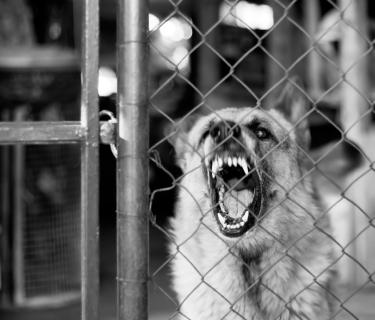
Dog Bite Prevention
Friday, May 19, 2017
National Dog Bite Prevention Week is May 21 – 27, 2017. According to the American Veterinary Medical Association (AVMA), more than 4.5 million people in the U.S. are bitten by dogs each year.
More than 800,000 of those people receive medical attention for dog bites. At least half of them are children, the most common victims of dog bites.
Here are some tips from the AVMA to prevent dog bites.
Be a responsible pet owner. Socialize a puppy so it feels at ease around people and other animals. Don’t put your pet in a situation where it feels threatened or teased.
Train your dog in the basic commands—sit, stay, no and come.
Walk and exercise your dog regularly to keep it healthy and provide mental stimulation. Use a leash or harness when in public.
Have your dog vaccinated against rabies and preventable infectious diseases. Parasite control and regular checkups are important because how your dog feels affects how it behaves.
Why do dogs bite? Any dog can bite no matter what size, sex, age or breed.
Dogs bite as a reaction to something. They are scared or were startled. They feel threatened. They are protecting something valuable to them—their puppies, their food or a toy.
Dogs may also bite when they are not feeling well. They could be sick or sore from an injury or illness and might want to be left alone.
Do dogs give us any warning signs? Since dogs can’t talk, they use their own vocalizations, body gestures and postures to communicate.
Sometimes dogs will yawn, pull their ears back or raise a paw if they are feeling worried.
If a dog tucks its tail under its belly or leg, lies down with a leg up or stiffens its body and stares at you, it could be trying to tell you that it’s frightened or threatened.
When a dog reacts by growling, snapping or biting, it’s telling you that it wants to be left alone – now!
If a dog is relaxed and friendly and seems happy to see you, it will probably welcome your attention. If the dog won’t look at you or is avoiding you by walking or turning away, it’s probably best to leave the dog alone. If the dog seems tense and nervous or seems to be staring at you, you’ll want to stay away.
Teach children how to prevent dog bites. Here are some simple tips to help children understand the importance of respecting dogs and avoiding bites:
- Avoid unknown dogs.
- Always ask owner permission before petting a dog.
- If a dog comes after them, teach children to ‘act like a tree’ and stand still, be quiet, keep their arms to their sides and look down.
- Avoid yelling, running, hitting or making sudden movements toward the dog.
- Never tease a dog by taking its toys, food or treats.
- Never pull on a dog’s tail or ears, climb on or try to ride dogs.
- If a dog is eating or sleeping, tell children to leave it alone.
If you or a child is bitten by a dog, seek medical attention immediately.
by Elisabeth Giedt, DVM
Veterinary Viewpoints is provided by the faculty of the OSU Veterinary Medical Hospital. Certified by the American Animal Hospital Association, the hospital is open to the public providing routine and specialized care for all species and 24-hour emergency care, 365 days a year.
